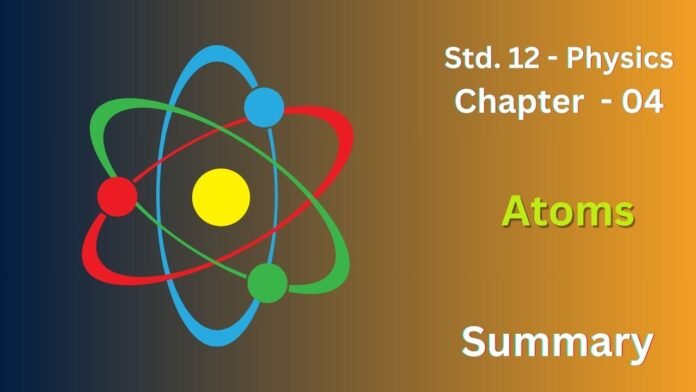The chapter “Atoms” in the 12th standard physics part 2 NCERT textbook delves into the structure and properties of atoms, moving beyond the classical models to embrace quantum mechanics. It traces the historical development of atomic models and explains key experimental observations.
Here’s a breakdown of the key concepts:
- Early Atomic Models: The chapter briefly touches upon the earlier models, including Dalton’s atomic theory and Thomson’s plum pudding model. These models were eventually superseded by more accurate representations.
- Rutherford’s Alpha-Particle Scattering Experiment: This pivotal experiment, where alpha particles were scattered by a thin gold foil, led to the discovery of the atomic nucleus. The experiment’s results, including the large-angle scattering of some alpha particles, could not be explained by previous models.
- Rutherford’s Nuclear Model: Based on his experiment, Rutherford proposed a model where the atom consists of a small, dense, positively charged nucleus at its center, surrounded by negatively charged electrons orbiting the nucleus like planets around the sun. However, this model had limitations, as classical electromagnetism predicted that orbiting electrons would lose energy and spiral into the nucleus.
- Atomic Spectra: The chapter discusses the observation of discrete spectral lines emitted by atoms. These spectral lines provided crucial clues about the energy levels within atoms. The chapter covers both emission and absorption spectra.
- Bohr’s Model of the Hydrogen Atom: Bohr’s model addressed the shortcomings of Rutherford’s model by incorporating quantum ideas. His postulates include:
- Electrons orbit the nucleus in specific circular orbits without radiating energy.
- Electrons can only occupy orbits with specific quantized angular momenta (L = nh/2π).
- When an electron transitions between orbits, it absorbs or emits a photon with energy equal to the difference in energy between the orbits (ΔE = hf).
- Energy Levels: Bohr’s model led to the concept of quantized energy levels within atoms. The chapter derives the expressions for the energy of the electron in the nth orbit and explains the origin of the spectral lines of hydrogen.
- Limitations of Bohr’s Model: While Bohr’s model successfully explained the hydrogen spectrum, it couldn’t explain the spectra of more complex atoms or other atomic phenomena.
- The de Broglie Explanation of Bohr’s Postulates: De Broglie’s hypothesis of matter waves provided a physical explanation for Bohr’s quantization condition for angular momentum. The idea is that the electron’s orbit must be a whole number of wavelengths long for the electron wave to be stable.
Exercise
1. Choose the correct alternative from the clues given at the end of the each statement:
(a) The size of the atom in Thomson’s model is……… the atomic size in Rutherford’s model. (much greater than/no different from/much less than.)
(b) In the ground state of………. electrons are in stable equilibrium, while in ………. electrons always experience a net force. (Thomson’s model/ Rutherford’s model.)
(c) A classical atom based on……….is doomed to collapse. (Thomson’s model/ Rutherford’s model.)
(d) An atom has a nearly continuous mass distribution in a……..but has a highly non-uniform mass distribution in………. (Thomson’s model/ Rutherford’s model.)
(e) The positively charged part of the atom possesses most of the mass in…….. (Rutherford’s model/both the models.)
Ans :
(a) no different from
(b) Thomson’s model , Rutherford’s model
(c) Rutherford’s model
(d) Thomson’s model , Rutherford’s model.
(e) Rutherford’s model.
2. Suppose you are given a chance to repeat the alpha-particle scattering experiment using a thin sheet of solid hydrogen in place of the gold foil. (Hydrogen is a solid at temperatures below 14 K.) What results do you expect?
Ans :
3. A difference of 2.3 eV separates two energy levels in an atom. What is the frequency of radiation emitted when the atom make a transition from the upper level to the lower level?
1. Convert the energy difference to Joules:
- We need to convert it to Joules (J) to use it in our calculations.
- 1 eV
- = 1.6 x 10^-19 J
- Energy difference = 2.3 eV * 1.6 x 10^-19 J/eV = 3.68 x 10^-19 J
2. Use the formula relating energy and frequency:
- The energy of a photon (the emitted radiation) is related to its frequency by the equation: E = h * f
- Where:
- E is the energy of the photon (3.68 x 10^-19 J)
- f is the frequency of the radiation (what we want to find)
- Where:
3. Solve for the frequency (f):
- Rearrange the equation f: f = E / h
- Calculation:
- f = (3.68 x 10^-19 J) / (6.626 x 10^-34 Js)
- f ≈ 5.58 x 10^14 Hz
The frequency of the radiation emitted when the atom makes a transition from the upper level to the lower level is approximately 5.58 x 10^14 Hz.
4. The ground state energy of hydrogen atom is -13.6 eV. What are the kinetic and potential energies of the electron in this state?
Ans :
Calculations
- Potential Energy:
- PE = 2 * E
- PE = 2 * (-13.6 eV) = -27.2 eV
- Kinetic Energy:
- KE = -E
- KE = -(-13.6 eV) = 13.6 eV
In the ground state of a hydrogen atom:
- Kinetic energy of the electron is 13.6 eV.
- Potential energy of the electron is -27.2 eV.
5. A hydrogen atom initially in the ground level absorbs a photon, which excites it to the n = 4 level. Determine the wavelength and frequency of photon.
Ans :
6. (a) Using the Bohr’s model calculate the speed of the electron in a hydrogen atom in the n = 1, 2, and 3 levels. (b) Calculate the orbital period in each of these levels.
Ans :
1. Speed of the electron:
The speed of an electron in the nth orbit of a hydrogen atom, according to Bohr’s model, is given by:
v = (ke^2) / (nh)
Let’s calculate the speeds for n = 1, 2, and 3:
- n = 1: v₁ = (ke^2) / h = (9 * 10^9 Nm^2/C^2 * (1.6 * 10^-19 C)^2) / (6.626 * 10^-34 Js) v₁ ≈ 2.18 x 10^6 m/s
- n = 2: v₂ = v₁ / 2 ≈ 1.09 x 10^6 m/s
- n = 3: v₃ = v₁ / 3 ≈ 7.27 x 10^5 m/s
2. Orbital period:
The orbital period (T) is the time it takes for the electron to complete one orbit. It can be calculated using the formula:
T = 2πr / v
where:
- T is the orbital period
- r is the radius of the nth orbit, given by r = n^2 * a₀ (a₀ is the Bohr radius, approximately 5.29 x 10^-11 m)
- v is the speed of the electron (calculated above)
Let’s calculate the periods for n = 1, 2, and 3:
- n = 1: r₁ = a₀ T₁ = 2πa₀ / v₁ ≈ 1.52 x 10^-16 s
- n = 2: r₂ = 4a₀ T₂ = 2π(4a₀) / v₂ ≈ 1.22 x 10^-15 s
- n = 3: r₃ = 9a₀ T₃ = 2π(9a₀) / v₃ ≈ 4.11 x 10^-15 s
7. The radius of the innermost electron orbit of a hydrogen atom is 5.3×10 m. What are the radii of the n = 2 and n =3 orbits?
Ans :
r_n = n^2 * a₀
where:
- n is the principal quantum number (1, 2, 3, …)
- a₀ is the Bohr radius (radius of the innermost orbit, approximately 5.3 x 10^-11 m)
Given that the radius of the innermost orbit (n=1) is 5.3 x 10^-11 m, we can calculate the radii for n=2 and n=3:
- n = 2: r₂ = 2^2 * a₀ = 4 * 5.3 x 10^-11 m = 21.2 x 10^-11 m = 2.12 x 10^-10 m
- n = 3: r₃ = 3^2 * a₀ = 9 * 5.3 x 10^-11 m = 47.7 x 10^-11 m = 4.77 x 10^-10 m
The radius of the n=2 orbit is 2.12 x 10^-10 m, and the radius of the n=3 orbit is 4.77 x 10^-10 m.
8. A 12.5 eV electron beam is used to bombard gaseous hydrogen at room temperature. What series of wavelengths will be emitted?
Ans :
9. In accordance with the Bohr’s model, find the quantum number that characterises the earth’s revolution around the sun in an orbit of radius 1.5 x 10″1 m with orbital speed 3 x 10 m/s. (Mass of earth = 6.0 x 1024 kg.)
Ans :
1. Angular Momentum:
First, calculate the Earth’s angular momentum (L) as it orbits the sun:
L = mvr
where:
- m (6.0 x 10^24 kg)
- v is its orbital speed (3 x 10^4 m/s)
- r is the radius of its orbit (1.5 x 10^11 m)
L = (6.0 x 10^24 kg) * (3 x 10^4 m/s) * (1.5 x 10^11 m)
L = 2.7 x 10^40 kg m^2/s
2. Bohr’s Quantization Condition (Adapted):
While Bohr’s model applies to electrons in atoms, we can adapt the idea of quantized angular momentum to this macroscopic case. We’ll assume the Earth’s angular momentum is quantized in a similar way:
L = nh / 2π
where:
- n is the quantum number (what we want to find)
- h(6.626 x 10^-34 Js)
3. Solve for n:
Rearrange the equation to solve for n:
n = 2πL / h
n = (2π * 2.7 x 10^40 kg m^2/s) / (6.626 x 10^-34 Js)
n ≈ 2.56 x 10^74
The quantum number that characterizes the Earth’s revolution around the sun is an incredibly large number, approximately 2.56 x 10^74.
This huge number makes the quantization of the Earth’s orbit completely unnoticeable in practice – classical mechanics is perfectly adequate to describe planetary motion.


